IN THIS ISSUE
- School art aids wildlife
- Train to monitor monarchs
- Humpback trend has sad footnote
- Don't miss spring's dawn chorus
 Students create a peregrine falcon collage. Masthead: finished collage. (Lori Lubin/Kingsley Elementary)
Visual art teacher Lori Lubin posed this question to her classes at Kingsley Elementary in Dunwoody:
How would you feel if you could do something to help Georgia’s rare animals?
The students’ answer was unanimous and excited: We want to help!
And they have. Through the Kingsley Cares: Save Georgia Wildlife Project created by Lubin, each student created a poster for the Give Wildlife a Chance Poster Contest and each class made a painted paper collage of a native animal.
The collages were then auctioned as part of the Dunwoody Nature Center’s Epic Earth Day event. Bids totaled $2,050. Sales of the 23 canvasses ranged from $50 to $250. All funds were donated to the center.
The project integrated art, technology and science (Dunwoody Nature Center educators provided in-school programs), and math (students added, graphed and compared collage sales).
The project also combined hands-on learning with a real-life contribution for conservation.
Lubin said with a laugh that the scope was “a little intense” and involved a learning curve. But she’s already exploring plans for next year. Included: Starting a Kingsley Cares: Protect Wildlife Club.
STATE POSTER WINNERS
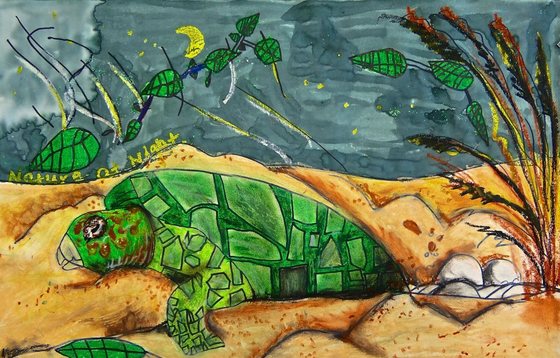 This sea turtle poster by Fourth-grader Amore Morgan led the contest's Division 3
Check out the news and see the artwork of statewide winners in the Give Wildlife a Chance Poster Contest. The posters also are on display at the State Botanical Garden in Athens through May 16.
Top
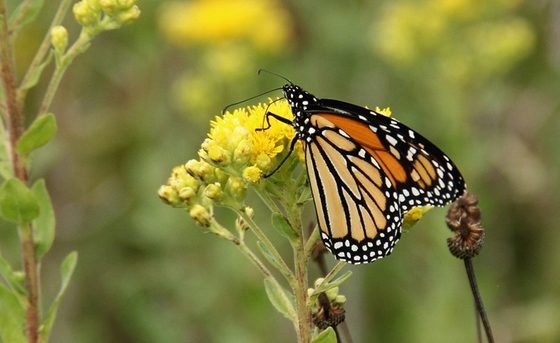 Monarch nectaring (Laura Lukens/Monarch Joint Venture)
By ANNA YELLIN
One of the world’s longest migrations is taking place in our backyards. And you can take part in it.
Each year, millions of monarch butterflies fly 3,000 miles across North America. The round-trip from as far north as Canada to as far south as Mexico can take four generations to complete.
Not surprisingly, the monarch has many secrets that scientists are studying. For example, while some areas where the butterflies overwinter are well-known – such as southern California and Mexico – biologists are trying to determine if a population winters on Georgia’s coast, and whether that is a product of environmental change.
This research is spurred by concern that monarchs are declining. Which is where citizen science comes in.
Because monarchs live throughout Georgia and are hard to track, public involvement in local conservation efforts and research can have a significant impact. What can you do?
Plant flowers that provide nectar for adult monarchs and vegetation for the caterpillars to eat. Monarch adults are generalist foragers. If your yard has a variety of native blooms through the growing season, these butterflies will come.
Yet the only plant monarch larvae feed on is milkweed. There are several species of milkweed. Selecting the species that naturally occurs in your area of the state is important. Learn more in this brochure.
Citizens can also help with research. In late April, DNR held a training session in Brunswick focused on the Integrated Monarch Monitoring Protocol. This national method is being used to compile baseline data for research.
Another session is scheduled for June 7-8 at Panola Mountain State Park near Stockbridge. Register here or email for more information.
Anna Yellin is environmental review coordinator for DNR’s Nongame Conservation Section.
MORE ON MONARCHS
PLANTING FOR …
IN THE NEWS
"Caterpillar 'road rage' could affect monarch migration," UGAToday
Top
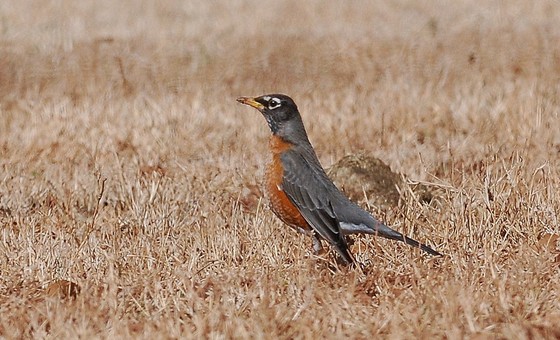 American robins are a key voice in the dawn chorus (Terry W. Johnson)
By TERRY W. JOHNSON
Whenever we talk about what makes spring such a beautiful time, invariably the discussion centers on the pleasing scent and kaleidoscope of colors displayed by spring flowers, the fresh, pale green of the foliage, and the pleasant weather.
But what's rarely mentioned is the dawn chorus by some of the bird world's most accomplished vocalists.
While this might seem odd – this is Mother Nature's top musical production of the year – I’m certain the oversight is because the songfest happens before most Georgians stumble out of bed.
But this lyrical extravaganza is worth getting up early for. …
Read the rest of Terry’s column to learn better appreciate spring’s dawn chorus.
Terry W. Johnson is a retired DNR nongame program manager and executive director of TERN, Nongame Conservation’s friends group. Read more in the Out My Backdoor library, Terry's Backyard Wildlife Connection blog and his new book, “A Journey of Discovery: Monroe County Outdoors.”
Top
 Humpback breaching off the Georgia coast (Tanner Hicks)
Four anglers returning from fishing the CCA-JL reef on Dec. 19 had an unforgettable encounter – one that has since been linked to a widely watched video.
About 10 miles east of Ossabaw Sound, Todd and Tanner Hicks, Garrett Franzel, and Ennis Hager spotted a humpback whale. Keeping a safe distance away, they watched as the nearly 30-foot-long whale breached “about every two minutes” and flapped its tail for almost an hour, said Todd Hicks, of Richmond Hill.
“It was surreal.”
The experience points to a real trend: Humpback whale sightings are up in the Southeast.
But it also has a sobering end. Two months later, the humpback was found dead off Cumberland Island, where DNR videoed sharks scavenging the carcass.
AT LEAST 16 IN 2018
Scientists monitoring North Atlantic right whales reported 43 humpback sightings and at least 16 individual whales off Georgia and Florida this winter, according to Melanie White, a biologist with Sea to Shore Alliance. The nonprofit focused on conserving coastal environments and species leads right whale aerial surveys each winter for DNR’s Nongame Conservation Section.
“While it is not unusual to spot humpback whales, their sighting numbers have definitely increased in recent years,” White said.
North Atlantic right whales, one of the world’s most imperiled whale species, remain the focus in the Southeast. Yet humpbacks are showing up more often. Particularly young ones.
Why isn’t known. Humpbacks along the Eastern Seaboard are part of a West Indies population that spends summers in the North Atlantic and each winter breeds in warm Caribbean waters. Yet their migration is thought to occur far offshore.
Hunted nearly to extinction, these whales known for their leaping, singing and up to 15-foot-long white flippers were listed as endangered in 1970. However, over the next four decades they recovered (related: humpback baby boom near Antarctica). Nine of 14 distinct populations worldwide – including the West Indies segment – were taken off the Endangered Species Act list in 2016.
Georgia may be seeing the overflow of that conservation success.
Boaters and anglers should be on the lookout, especially in winter and spring. Unlike right whales, humpbacks sometimes swim close to shore. Sightings have been documented off Georgia as late as May.
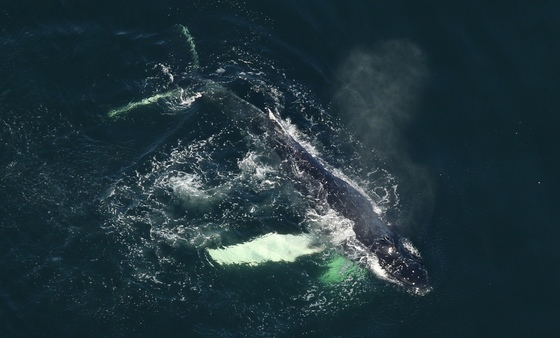 The same humpback showing signs of entanglement in December; close-up below (FWC)
ENTANGLEMENT FALLOUT
But
how did the humpback seen breaching in December end up as food for
sharks in February? Entanglement might have played a part.
 Six
months ago, the whale – then just a calf – was photographed off
Massachusetts with monofilament gillnet in its mouth. As with right
whales, entanglement in commercial fishing gear is a threat for
humpbacks.
Two days before the Georgia anglers saw the humpback, the Florida Fish and Wildlife Conservation Commission spotted it off Ponte Vedra Beach in northeast Florida.
The
whale was “very active, similar to the Hicks’ sighting,” wrote Katie
Jackson, a marine mammal biologist with FWC. “But we think it was still
entangled.”
Researchers
will be checking images taken by the fishermen for evidence of
entanglement. They believe the whale may have shed the rest of the
gillnet between December and February. But it was likely too little, too
late.
When FWC staff saw the humpback again, on Feb. 24 some 30 miles off Cumberland Island, it was dead.
DNR later videoed great whites and other sharks eating the carcass. Media outlets from the U.S. to the United Kingdom carried the video.
Hicks was sad to hear about the whale’s death. The encounter with his group, he said, had been “epic.”
|
HUMPBACKS AT A GLANCE
-
Weight: 25-40 tons; newborns weigh about 1 ton (2,000 pounds)
-
Length: up to 60 feet; females are larger than males
-
Lifespan: about 50 years
-
Diet: small crustaceans and fish; adults can consume 3,000 pounds a day
-
Behavior: breaching (watch), slapping the surface and complex singing (listen)
-
Protected: under the Marine Mammal Protection Act of 1973. Boaters and others remain at least 100 yards away (marine wildlife viewing guidelines).
-
Generalist vs. specialist species: Humpbacks, an example of a generalist species, eat a wide range of foods (including fish). A specialist species such as the North Atlantic right whale has a more focused diet (primarily tiny crustaceans called copepods).
Sources: NOAA, DNR
Top
For the fifth straight year, Cumberland Island has reported Georgia's first loggerhead sea turtle nest of the year. National Park Service staff found the nest Tuesday morning. DNR Sea Turtle Program Coordinator Mark Dodd said loggerhead nesting usually begins in early May and hits full stride by June.
The Georgia Outdoor Stewardship Act will be on the statewide ballot in November. This week, Gov. Nathan Deal signed the constitutional amendment (photo) allowing voters to decide whether to dedicate a share of the sales tax on recreational items to conserve the state's wildlife, lands and waters.
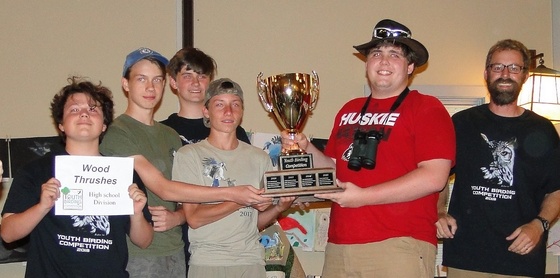 The winning Wood Thrushes and competition coordinator Tim Keyes (Rick Lavender/DNR)
Birds and birders won during the 13th annual Youth Birding Competition April 27-28. The five teens on the winning team, the Wood Thrushes, saw or heard 161 species during the 24-hour contest.
Why does DNR study mussels and how? Boost your mental muscles with this blog post “Mussel mania in the lower Flint.”
The first 500 youth at the Keeping Georgia Wild festival May 19 will get a T-shirt. But all attending the free fest at Charlie Elliott Wildlife Center near Mansfield can try activities varying from archery and fishing to shooting sports and tree climbing. Also: kids fishing events near you.
Barking up the right arm? Below, senior wildlife biologist John Jensen shows a barking treefrog found while collecting wetland plants at Mayhaw Wildlife Management Area for The Amphibian Foundation’s flatwoods salamander breeding program at Blue Heron Nature Preserve.
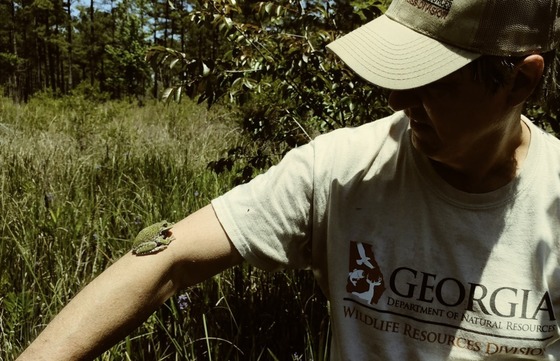 Barking treefrog (Mark Mandica/The Amphibian Foundation)
COMING UP
May 11 – Bird banding, 5:30 a.m. Panola Mountain State Park, Stockbridge. Other dates include: 5:15 a.m. May 26, 5:15 a.m. June 7 and 22. Details: Georgia Important Bird Areas Program Coordinator Charlie Muise.
May 17 – Georgia Plant Conservation Alliance members' meeting, White Oak Pastures, Bluffton
May 19 – Keeping Georgia Wild Family Festival, 10 a.m.-2 p.m., Charlie Elliott Wildlife Festival, Mansfield. Free. Includes archery, fishing, shooting sports, gun safety, mini-boat rides, solar viewing, outdoor exhibitors, wildlife demonstrations.
May 22-23 – First Detector invasive species workshop, May 22-23, Altamaha Plantation, Brunswick
May 29, 30 – Chattahoochee-Oconee National Forests Foothills Landscape Project workshops, 10:30 a.m.-3:30 p.m. May29 and 5-8 p.m. May 30, Fieldale Fun House, Clarkesville
WHAT YOU MISSED …
In the last Georgia Wild.
— “My job is to kill hogs”
— Head-start for rare salamanders
— Sad news for Tallulah Gorge falcons
Top
 DNR's Brett Albanese with sicklefin redhorse (Peter Dimmick/DNR)
(+video) "Searching for the ‘salmon of the South,’" WABE-FM (90.1, Atlanta)
"Locals shine in state birding competition," The LaGrange Daily News. Also: SaportaReport
"Dozens of bats invade apartment building," WSB-TV (Ch. 2, Atlanta)
"Incredible story of owl's death-defying road trip," Audubon
"Tick and mosquito infections spreading rapidly," The New York Times
"How America’s only native stork saved itself from extinction," Sierra
"Surprise! Eating pills made of rattlesnake not recommended," Cosmos
VIDEO AND AUDIO
"It isn't too late for wildlife in Georgia" (conservation with a T-rex). Also on YouTube. DNR
(audio) "Nocturnal migration of songbirds," BirdNote
"Your best waters" (benefits of national forests and waters), U.S. Forest Service
"Journeying with bats across Mexico," National Geographic
Top
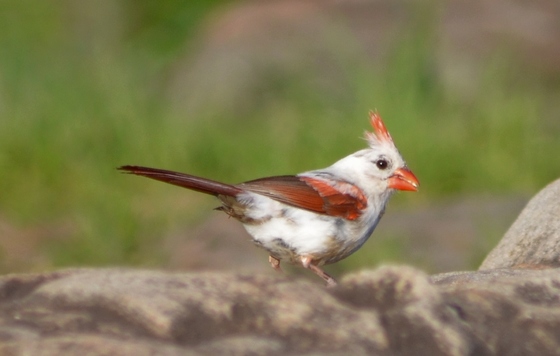 Leucistic cardinal at Kennesaw Mountain (Evan Schneider)
This leucistic cardinal has been turning heads at Kennesaw Mountain National Battlefield Park. Evan Schneider of Macon took the photograph during a recent birding trip to the Kennesaw park. Leucism is a condition involving the partial loss of pigmentation – turning, for example, bold red to patchy white – but not affecting pigment cells in the eyes (unlike with albinism). A genetic mutation that renders pigments derived from food yellow instead of red likely produced the yellow northern cardinal that caused a stir near Birmingham, Ala., this winter.
Top
|